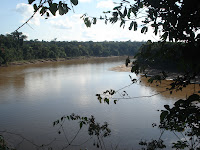 As I mentioned in an earlier blog entry the resort was like from out of a Hollywood set. Constructed in timber and bamboo it blended nicely with the surrounding jungle.
As I mentioned in an earlier blog entry the resort was like from out of a Hollywood set. Constructed in timber and bamboo it blended nicely with the surrounding jungle.(Left - my bedroom with the mosquito netting rolled up on my bed)
Rooms had only 3 walls giving a outlook to the nearby jungle. Rooms also had no doors, but hanging curtains. Natural
 ly all beds were fitted with mosquito netting, and we also had brought anti malaria tablets - just in case.
ly all beds were fitted with mosquito netting, and we also had brought anti malaria tablets - just in case.(Right - another view of the bedroom looking to the main entrance. Curtains to the left are to the bathroom)

(Left - rooms were equipped with hammocks for that siesta time)

(Right - on a stroll by myself along the jungle tracks I found this colorful butterfly - called "mariposa" in Spanish)

(Left - I walked to this outlook overlooking the Tambopata river where I could watch the passing parade)

(Right - overhead the birds wheeled)

(Left - a very large catterpillar on the path)

(Left - spot the frog in the picture?)
(Right - the dining room on the lower level - we sat with our guides for each meal which was a buffet - not a huge range of foods, but satisfying)


(Right - overhead the birds wheeled)

(Left - a very large catterpillar on the path)

(Left - spot the frog in the picture?)

(Right - the dining room on the lower level - we sat with our guides for each meal which was a buffet - not a huge range of foods, but satisfying)

(Left - our riverboat waits for the final trip back to Peurto Mondonaldo

(Right - it was a quicker trip back as we were now with the current, but still around 3 hours - so for some it was a good time to doze)

(Left - a bit difficult to see, but a flock of birds were squawking in the tree - our boat stopped for a look)

(Right - it was a quicker trip back as we were now with the current, but still around 3 hours - so for some it was a good time to doze)

(Left - a bit difficult to see, but a flock of birds were squawking in the tree - our boat stopped for a look)










































